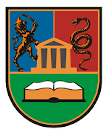Please use this identifier to cite or link to this item:
https://scidar.kg.ac.rs/handle/123456789/21861Full metadata record
| DC Field | Value | Language |
|---|---|---|
| dc.contributor.author | Spasić, Jelena Lj. | - |
| dc.date.accessioned | 2024-12-27T19:30:39Z | - |
| dc.date.available | 2024-12-27T19:30:39Z | - |
| dc.date.issued | 2024 | - |
| dc.identifier.issn | 03505286 | en_US |
| dc.identifier.uri | https://scidar.kg.ac.rs/handle/123456789/21861 | - |
| dc.description | Realizaciju ovog istraživanja finansiralo je Ministarstvo nauke, tehnološkog razvoja i inovacija Republike Srbije (Ugovor br. 451-03-65/2024-03/200140). | en_US |
| dc.description.abstract | The subject of study is the language of the novel The Moss Coat (Kaput od mahovine), written by Stefan Mitić Tićmi. Using the criteria of integral stylistics, the paper analyzes the artistic effects of phonetic word g mes and graphostylic idiosyncrasies in the novel The Moss Coat, which can be classified as lyrical prose, but also has the characteristics of a fairy tale and a coming-of-age no vel. Mitić’s novel leads the reader to a deeper introspective insight, and at the same time requ res the reading of the linguistic structure, in which phonostyles and graphostyles are woven together with various types of deviation, which at the same time complicates the reception and requires greater engagement of the reader. The main character of the novel The Moss Coat is the boy Najdan, a dreamer and a loner, who has a tree growing out of his back. The tree is a metaphor for a burden, a burden that each of us grows up with, but above all it is the burden of an ar ti stic gift. On the path of growing up, vividly depicted through the branches of a tree, art brings release. The poetic story of maturation and isolation necessary for creation abounds in phonostylistic and graphostylistic figures. Playing with sounds is realized through onomatopoeias, multiplied interjections, imitation, vocal segmentation of words, sound games with words and puns realized by minus-procedure. The emotional attitude of the main character and the change of the narrative form are expres sed by the graphostylemic process. Stylogenity is also realized by writing words to get her, as well as by kenning and antonomasia, tropes that are created by graphological deviation, and are characteristic of the language of literature for children and young people. | en_US |
| dc.language.iso | sr | en_US |
| dc.publisher | Međunarodni centar književnosti za decu ZMAJEVE DEČJE IGRE | en_US |
| dc.relation.ispartof | Detinjstvo, časopis o književnosti za decu | en_US |
| dc.rights | CC0 1.0 Universal | * |
| dc.rights.uri | http://creativecommons.org/publicdomain/zero/1.0/ | * |
| dc.subject | Stefan Mitić Tićmi | en_US |
| dc.subject | literature for youth | en_US |
| dc.subject | linguistic stylistics | en_US |
| dc.subject | integral stylistics | en_US |
| dc.subject | phonostyleme | en_US |
| dc.subject | graphostyleme | en_US |
| dc.subject | word play | en_US |
| dc.title | RAZIGRANI JEZIK ROMANA KAPUT OD MAHOVINE | en_US |
| dc.title.alternative | THE PLAYFUL LAN GUA GE OF THE NO VEL THE MOSS CO AT (KA PUT OD MAHOVINE) | en_US |
| dc.type | article | en_US |
| dc.description.version | Published | en_US |
| dc.identifier.doi | 10.46793/Childhood24.4.84S | en_US |
| dc.type.version | PublishedVersion | en_US |
| Appears in Collections: | Faculty of Education, Jagodina | |
Files in This Item:
| File | Description | Size | Format | |
|---|---|---|---|---|
| Detinjstvo_04_2024-84-91.pdf | 112.7 kB | Adobe PDF |  View/Open |
This item is licensed under a Creative Commons License


